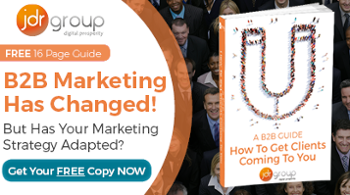Why Is Email Marketing An Important Part Of Inbound Marketing, When It Is An Outbound Strategy?

Email marketing is frequently seen as the classic outbound digital marketing strategy, but it also plays an important part in inbound marketing. While outbound emails focus on a specific sales ask and are often targeted at ‘cold’ new business leads, inbound email marketing seeks to increase the value of existing or lapsed customers through a process of targeted relationship building.
Here are some of the core reasons why emails should be included in any inbound marketing toolkit:
1) Target specific buyers
The old-fashioned way of conducting email marketing was to purchase a list, create an email and blast it out to the whole lot. This was called a ‘shot gun’ or ‘fire and forget’ method for good reason. It was generic, impersonal and highly inaccurate. The only way to gain results through such a strategy was to rely on sheer weight of numbers to bring in results through statistical chance.
Inbound marketing uses far more precise methods. Using a CRM it is possible to segment your contact database based on their relationship with you, growth potential, geographical location, job position or industry; or any other valuable metric. You can then go about crafting a specific message that meets their requirements. The more an email pre-empts the questions your prospects may have about your services, and help them understand your relevance to them, the higher your click through and conversion rate.
2) Easy to personalise
Once you have established your segments or buyer personas, you are free to completely personalise each email. In doing so, use should be made of every piece of personal data you can get your hands on, as emails featuring the prospects first name are far more likely to be opened and those that do not. This is your chance to make your prospect feel you care about them, you understand their needs and can provide them a valuable service. With emails you are not limited to simply personalising a little bit of text. Each segment can have a completely different campaign approach, with graphics, written content and video tailored to their needs. This is what makes email marketing such a cost-effective and powerful inbound marketing tool.
Timing can be personalised as well. For each segment, there will be an optimum time to send the email to boost click through rates. This may be based on the prospect’s time zone, viewing habits or working pattern. Insight can be gained into this through analytics. For instance, you may find that the prospects in ‘Segment A’ respond best to your emails when sent on a Wednesday afternoon. A marketing automation package will help you time your campaigns, so that each segment receives their email at the best time for them.
3) Create shareable content

Email-based content has a high share value. At the click of a button a prospect can share your email with friends, colleagues, clients and family. Email content can also be easily shared through social media. Emails are a very effective way to disseminate infographics and video content. The content itself is usually hosted on a part of your website, with a link embedded in each email. As the prospect clicks through to the content they are taken onto your website, and can then share the relevant URL with their network through social channels. You can also use emails to boost your social media following on YouTube or Facebook, by creating content that can easily be shared on these platforms. For more on creating content read: How To Bring Your Creativity To Life: 4 Easy Ways To Help Create Content
4) Low cost, effective results
Email marketing has very few of the costs associated with traditional direct mail; no printing or postage costs, no pay per click expenses. Sending emails is cheap, effective and comparatively quick, especially once you have established a portfolio of adaptable templates. It is also the most effective way of reaching out to an international market, as it eliminates all the time lags and expenses of contacting overseas customers by other means.
5) Fast Results
Unlike other forms of advertising, which can be slow to yield results, results from email marketing can be astonishingly quick. So long as the campaign is timed correctly, it is not uncommon to see enquiries or sales coming through within minutes of the email being sent. You can monitor your campaign statistics in real-time and watch your customers respond. There really aren’t too many better feelings than this!
6) Effects can easily be measured
Email marketing is a dream come true for analysts. It allows you to measure very precise metrics that give powerful insight into customer behaviour and the value of your data. Find out exact figures for delivery rates, open rates, which recipients have clicked through and when, how many people have subscribed or unsubscribed. With analysis playing such an important role in inbound marketing, the more in-depth and accurately results can be measured, the more valuable they’ll be in planning subsequent campaigns. In this, email marketing ticks all the boxes. You will know exactly how effective each email has been, and how much it has cost you to generate every lead. From this you can measure ROI from campaign to campaign, using this as benchmark to evaluate your messages.
Email marketing has such potential as an inbound marketing tool that you really cannot afford to ignore it. It is a tried and tested method of spreading brand awareness and sharing content, in a way that keeps your business at the forefront of your prospect’s attention, and makes it more likely that they’ll convert into leads.


